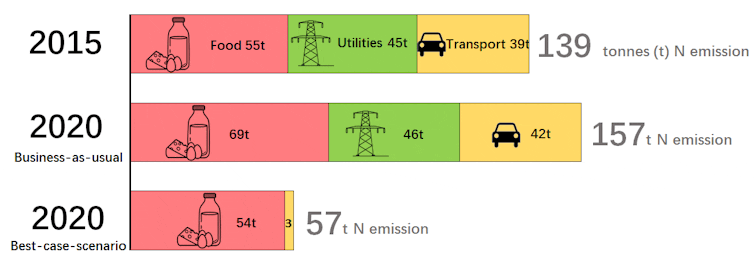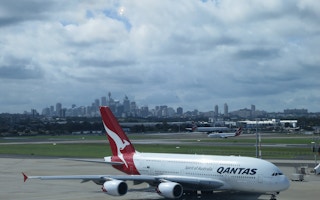Nitrogen pollution has significant environmental and human health costs. Yet it is often conflated with other environmental problems, such as climate change, which is exacerbated by nitrous oxide (N₂O) and nitrogen oxides (NOₓ), or particulate smog, to which ammonia (NH₃) also contributes.
One way to understand our nitrogen use is to look at our nitrogen footprint. This is the amount of reactive nitrogen, which is all forms of nitrogen other than inert nitrogen gas, released into the environment from our daily activities that consume resources including food and energy.
Our earlier research showed that Australia has a large nitrogen footprint. At up to 47kg of nitrogen per person each year, Australia is far ahead of the US (28kg per person), the second on the leaderboard of per capita reactive nitrogen emissions. Australians’ large nitrogen footprints are created largely by a diet rich in animal protein and high levels of coal use for energy.
The nitrogen footprint
Our new research, published in the Journal of Cleaner Production, takes this concept further by measuring the nitrogen footprint of an entire institution, in this case the University of Melbourne.
The institutional nitrogen footprint is the sum of individual activities at the workplace and institutional activities, such as powering laboratories and lecture theatres in the case of a university.
We calculated that the university’s annual nitrogen footprint is 139 tonnes of nitrogen. It is mainly attributable to three factors: food (37 per cent), energy use (32 per cent) and transport (28 per cent).

At the university, food plays a dominant role through the meat and dairy consumed. Nitrogen emissions from food occur mainly during its production, whereas emissions from energy use come mainly from coal-powered electricity use and from fuel used during business travel.
Cutting nitrogen
We also modelled the steps that the university could take to reduce its nitrogen footprint. We found that it could be reduced by 60 per cent by taking action to cut emissions from the three main contributing factors: food, energy use, and travel.
The good news is if the university implements all the changes to energy use detailed in its Sustainability Plan – which includes strategies such as adopting clean energy (solar and wind), optimising energy use and buying carbon credits – this would also reduce nitrogen pollution by as much as 29 per cent.
Changing habits of air travel and food choices would be a challenge, as this requires altering the behaviour of people from a culture that places tremendous value on travelling and a love for coffee and meat.
Generally, Australians fly a lot compared to the rest of the world, at significant cost to the environment. We could offset the travel, and we do take that possibility into account, but as others have written before us, we should not make the mistake of assuming that emissions offsets make air travel “sustainable”.
“
Nitrogen emissions from food occur mainly during its production, whereas emissions from energy use come mainly from coal-powered electricity use and from fuel used during business travel.
The question that perhaps need to be asked, for work travel, is “to travel or not to travel?” Let’s face it, why are so many academic conferences set in idyllic locations, if not to entice us to attend?
Animal products are major contributors to nitrogen emissions, given the inefficiency of conversion from the feed to milk or meat. Would people be willing to change their latte, flat white or cappuccino to a long black, espresso or macchiato? Or a soy latte?
As 96 per cent of the nitrogen emissions occur outside the university’s boundaries, their detrimental effects are invisible to the person on the ground, while the burden of the pollution is often borne far away, both in time and space.
![]() But, as our study shows for the first time, large institutions with lots of staff are well placed to take steps to cut their large nitrogen footprint.
But, as our study shows for the first time, large institutions with lots of staff are well placed to take steps to cut their large nitrogen footprint.
Ee Ling Ng is a Research fellow at the University of Melbourne; Deli Chen is Professor at the University of Melbourne, and Xia Liang is a PhD candidate at the University of Melbourne. This article was originally published on The Conversation.


















